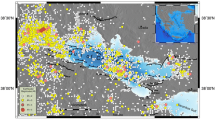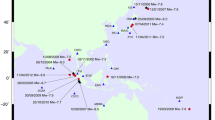Abstract
In a variety of biological and physical phenomena, temporal fluctuations are found, which are not explainable as consequences of statistically independent random events. If these fluctuations are characterized by a power spectrum density S(f) decaying as f −β at low frequencies, this behaviour is called 1/f noise.
Counting statistics applied to earthquake activity data leads to three time scales with different characteristics, represented by the exponent β: at interval lengths less than 1 h, the shocks are randomly distributed as in a Poisson process. For medium time intervals (1 day to 3 months), the exponent 1 + β is larger (1.4 for M 0=3), but approaches unity for higher threshold magnitudes M 0. In longer time ranges the exponent assumes values near 1.55, however, with increasing statistical variation at higher M 0, due to lower counts.
The temporal sequence is different from white noise; thus, it might be fruitful to apply neural network algorithms, because this method allows predictions in some other cases with similar characteristics.
Similar content being viewed by others
References
Bak P (1990a) Simulation of self-organized criticality. Physica Scripta T33:9–10
Bak P (1990b) Is the world at the border of chaos? Ann NY Acad Sci 581:110–118
Bak P, Chen K (1991) Self-organized criticality. Sci Am 264/1:46–53
Bak P, Paczuski M (1995) Complexity, contingency, and criticality (in press)
Bak P, Tang C (1989) Earthquakes as a self-organized critical phenomenon. J Geophys Res 94 (B11):15635–15637
Bak P, Tang C, Wiesenfeld K (1987) Self-organized criticality: An explanation of 1/f noise. Phys Rev Lett 59:381–384
Christensen K, Olami Z, Bak P (1992) Deterministic 1/f noise in nonconservative models of self-organized criticality. Phys Rev Lett 68:2417–2420
Cox DR, Isham V (1980) Point processes. Chapman and Hall, London
Herz AVM, Hopfield JJ (1995) Earthquake cycles and neural reverberations: collective oscillations in systems with pulse-coupled threshold elements. Phys Rev Lett 75:1222–1225
Koroutchev K, Scharf R, Meesmann M, Kniffki K-D (1996) Fractal point processes and counting statistics. Fractals (in press)
Kniffki K-D, Braun C, Klusch A, Tran-Gia Ph (1995) 1/f β-fluctuations in bipolar affective illness. In: Novak MM (ed) Fractal reviews in the natural and applied sciences. Proc Fractal 95, Marseille, Feb. 1995, pp 153–162
Lowen SB (1992) Fractal stochastic processes. Thesis, Columbia University
Lowen SB, Teich MC (1993) Fractal renewal processes generate 1/f noise. Phys Rev E 47:992–1001
Meesmann M, Gruneis F, Flachenecker P, Kniffki K-D (1993a) A new method of analysis of heart rate variability: counting statistics of 1/f fluctuations. Biol Cybern 68:299–306
Meesmann M, Boese J, Chialvo DR, Kowallik P, Bauer WR, Peters W, Gruneis F, Kniffki K-D (1993b) Demonstration of 1/f fluctuations and white noise in the human heart rate by the variance-time curve: implications for self-similarity. Fractals 1:312–320
Olami Z, Christensen K (1992) Temporal correlations, universality, and multifractality in a spring-block model of earthquakes. Phys Rev A 46:R1720-R1723
Rubeis V de, Dimitriu P, Papadimitriou E, Tosi P (1993) Geophys Res Lett 20:1911–1914
Scharf R, Meesmann M, Boese J, Chialvo DR, Kniffki K-D (1995) General relation between variance-time curve and power spectral density of point processes exhibiting 1/f β-fluc-tuations, with special reference to heart rate variability. Biol Cybern 73:255–263
Scharf R, Meesmann M, Kowallik P, Boese J, Kniffki K-D (1996) Methodological aspects of ultra low and very low frequency analysis of heart rate variability (submitted)
Sornette A, Sornette D (1989) Self-organized criticality and earthquakes. Europhys Lett 9:197–202
Utsu T (1970) Aftershocks and earthquake statistics (II). J Faculty Sci (Hokkaido University Ser. VII) 3:197–266
Author information
Authors and Affiliations
Rights and permissions
About this article
Cite this article
Bittner, H.R., Tosi, P., Braun, C. et al. Counting statistics of f −β fluctuations: a new method for analysis of earthquake data. Geol Rundsch 85, 110–115 (1996). https://doi.org/10.1007/BF00192068
Received:
Accepted:
Published:
Issue Date:
DOI: https://doi.org/10.1007/BF00192068




